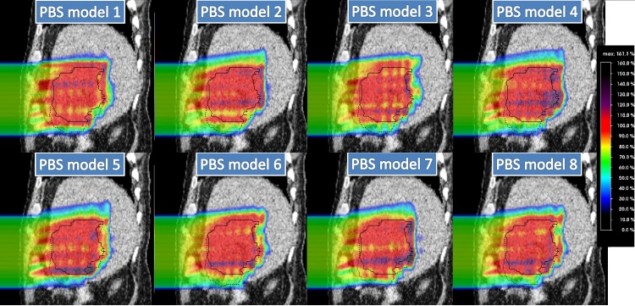
The use of motion mitigation strategies is of critical importance when delivering proton therapy to a tumour affected by organ movement. If motion is not adequately addressed, radiation delivered by pencil-beam scanning (PBS) could miss the precise tumour target, thus not delivering the planned dose and potentially hitting adjacent healthy tissue or organs-at-risk.
A study conducted in Switzerland comparing motion mitigation performance among different PBS delivery systems has shown that, for treatment of liver tumours, re-gating is an effective motion mitigation approach for all the PBS systems studied. Re-gating, the combination of gating (a system that tracks a patient’s normal respiratory cycle and monitors the movement of a tumour) and rescanning, was more effective and robust than either single technique (Radiother. Oncol. doi: 10.1016/j.radonc.2018.01.019).
For any PBS system, the target volume of a tumour is scanned both laterally and longitudinally by a sequence of narrow proton pencil beams. The maximum applicable beam current used to deposit a planned dose at a pre-defined location differs between cyclotron- and synchrotron-based systems. Modulation of beam intensity during radiation delivery may also vary among PBS systems. Because of these factors, the exact timing of the delivery of each pencil beam from the same treatment plan can be very different depending upon the PBS system used.

Lead author Ye Zhang, a research scientist of the Center for Proton Therapy at the Paul Scherrer Institut (PSI), and co-authors evaluated potential differences in the effectiveness of re-gating as a function of different PBS systems. They also evaluated variations in delivery time-lines using varying clinical assumptions.
The research team used four-dimensional CT (4DCT) and 4D MRI datasets from six patients with liver tumours with irregular motion greater than 10 mm. They performed 4D dose calculations for seven different field doses, simulating four different starting phases of the delivery of each field. For each case, they created 16 two-field plan combinations considering all possible starting phases.
In total, the researchers simulated 54 motion mitigation approaches for each of eight PBS scenarios, patient, prescribed dose and field for single field-plans. These were combined with 1-9x layered and volumetric rescanning and three gating window sizes. The PBS scenarios included spot or raster scanning, layered or volumetric rescanning, gating, constant or varying beam current, and cyclotron or synchrotron beam sources.
For both layered-and volumetric-rescanning, an adapted re-scanning approach was used to assure that all beam weights were deliverable. Gating signals were determined by tracking the external surface motion from the 4D-MRI data sets used for modelling the motion and by applying a linear, internal-external motion correction.
The researchers compared the qualities of all the 4D plans to determine dosimetric impacts and treatment efficiency. Differences in the magnitude of interplay effects were analysed. They also selected 13 typical motion mitigation approaches from the 54 options to perform a more comprehensive analysis.
The authors reported notable differences in dose distribution between plans delivered among the PBS models. However, combining gating with either rescanning mode achieved considerable improvements in mean homogeneity index and its uncertainty band. Robust results were attained across all PBS delivery scenarios, and a large range of fraction prescription doses and motion parameters.
The choice of raster or spot lateral scanning had insignificant dosimetric impact. Raster scanning reduced delivery time by 25-53% compared with spot scanning for all accelerator types and beam current models for the re-gating scenarios. Variable beam current models reduced treatment time for both cyclotron (by between 2-10%) and synchrotron (by 3-28%) PBS systems. The major advantage of cyclotron-based systems was a reduction of up to 70% in treatment time for all investigated field doses, especially when a cyclotron was combined with variable layer-by-layer beam current. However, treatment time reduction occurred with all motion mitigation techniques.
“For many years at PSI, we have been developing a comprehensive 4D dose calculation and optimization platform, taking into account many dedicated models of PBS scanning dynamics and deformable motion variability,” said Zhang. “With the help of this tool, we are able to explore many dimensions for the unrelated uncertainties in 4D PBS treatments, to investigate their dosimetric impacts, to evaluate the plan robustness, and eventually to suggest the optimum motion mitigation solution for individual patient treatments.”



